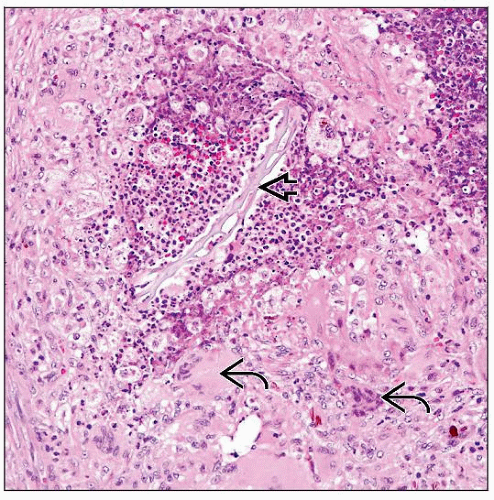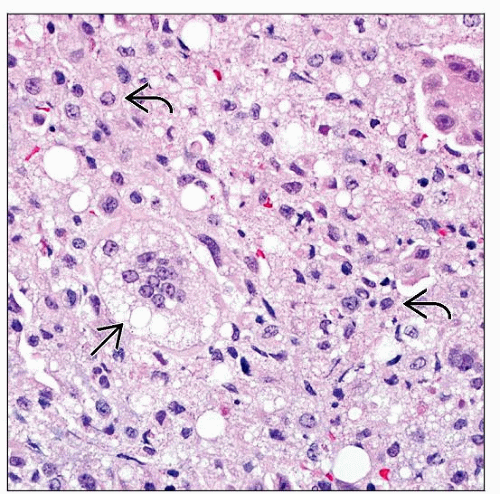Aspiration
Monica P. Revelo, MD, PhD
Brandon T. Larsen, MD, PhD
Key Facts
Terminology
Entry of particulate matter, fluid, or secretions from stomach, esophagus, oral cavity, nasal cavity, or oropharynx into airway below level of true vocal folds
Aspiration pneumonia is pathologic consequence of aspiration
Clinical Issues
Common in children and infants with feeding and swallowing problems due to neurological diseases or anatomical anomalies
Depends on type of material aspirated as well as extent of injury
Meconium aspiration is fatal in 5-10% of cases
Mortality is high in acute aspiration of gastric contents
Types of aspiration syndromes
Meconium-contaminated amniotic fluid
Fluids contaminated with bacteria
Chemical pneumonitis (Mendelson syndrome)
Airway obstruction
Exogenous lipoid pneumonia
Image Findings
Imaging findings depend on type and severity of aspiration
Macroscopic Features
Parenchymal consolidation distal to obstructed airway may be seen in any type of aspiration
Microscopic Pathology
Histologic features vary with type of aspirate
TERMINOLOGY
Definitions
Entry of particulate matter, fluid, or secretions from stomach, esophagus, oral cavity, nasal cavity, or oropharynx into airway below level of true vocal folds
Aspiration pneumonia is pathologic consequence of aspiration
ETIOLOGY/PATHOGENESIS
Implicated Mechanisms
Failure of normal airway clearing mechanisms (glottic closure, cough reflex)
Type and amount of aspirate determines mechanism of injury
Aspirate inoculum (i.e., gastric content) may produce direct toxic effects (chemical pneumonitis)
Stimulation of inflammatory process from large inoculum contaminated with bacteria
Obstruction of airways due to large amount of aspirate (> 0.3 mL/kg)
Epithelial cell and alveolar macrophage injury result in release of chemical mediators
Neutrophils are attracted and activated, with subsequent activation of proteases and production of reactive oxygen species
CLINICAL ISSUES
Epidemiology
Incidence
Common in children and infants with feeding and swallowing problems due to neurological diseases or anatomical anomalies
Age
Peak incidence of foreign body aspiration: 10-24 months
Presentation
Acute manifestations
Cough
Wheezing
Respiratory distress
Atelectasis
Airway obstruction
Long-term manifestations
Bronchiectasis
Bronchiolitis obliterans
Follicular bronchiolitis
Recurrent and prolonged respiratory infections
Chronic lung disease
Laboratory Tests
Bronchoalveolar lavage (BAL)
Shows increased cellularity (lymphocytes, eosinophils, macrophages)
Lipid-laden macrophages in great numbers
Multinucleated giant cells containing lipid droplets
Presence of pepsin is indicative of aspiration of gastric contents
Videofluoroscopic swallow study
Fiberoptic endoscopic evaluation of swallowing
Treatment
Options, risks, complications
Depend on type of aspirated material and extent of injury
Surgical approaches
Removal of aspirated object with fiberoptic or rigid bronchoscope
Antireflux procedures (e.g., fundoplication)
Gastrostomy
Larynx closure for intractable aspiration
Drugs
Antibiotics used when infection is suspected
Corticosteroids in cases of exogenous lipoid pneumonia
Surfactant therapy
Respiratory support
Mechanical ventilation
Stay updated, free articles. Join our Telegram channel

Full access? Get Clinical Tree








